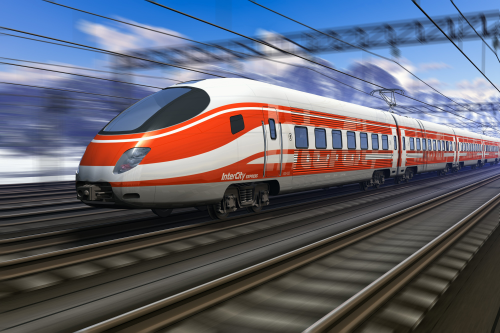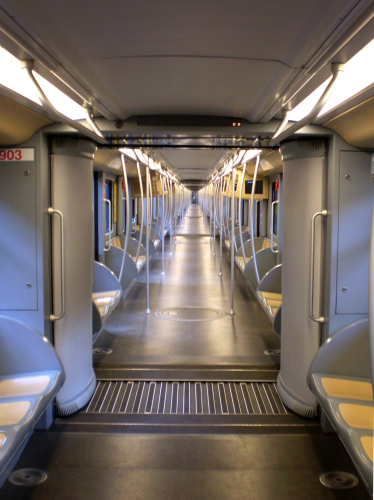

Composites have made a contribution to railcar exteriors, particularly those in high-speed trains and on short-distance regional, suburban and metropolitan trains where multiple stops place a premium on rapid acceleration and deceleration. However, they are taking longer to break through into primary load bearing structure. Clearly, it is hard to envisage reinforced plastics supplanting the bogies, chassis beams etc that are the undisputed province of heavy metal; even so there are niche areas where the lighter, more conformable materials can contribute.
One area where composites have conquered is front ends, where the curvy, streamlined look has become fashionable. However, application to high-speed trains in particular is driven not by fashion but by aerodynamics and weight. Air resistance rises geometrically with speed and becomes very forceful at running speeds extending to over 200 mph in some cases. Streamlined front ends with curved sloping surfaces, fair lines and smooth finishes, a combination that moulded composites are well suited for, can literally take the edge off this effect. Such cabs also have far fewer parts than metal equivalents along with superior structural integrity because there are fewer joins. In series production runs, they can be cheaper to manufacture than metal cabs.
| One area where composites have conquered is front ends, where the curvy, streamlined look has become fashionable. However, application to high-speed trains in particular is driven not by fashion but by aerodynamics and weight. |
Many trains produced in Europe, the USA and other developed territories now have composite front ends, but less developed nations are taking to them as well. Several years ago, Kineco Pvt Ltd introduced India’s first front-end cab for a diesel electric multiple unit (DEMU) train. The single-piece GRP structure included a driver’s console and cab interior panelling. Resin infusion and vacuum bagging (inside autoclave) processes were used to secure good mechanical properties. Based on satisfactory field performance of the initial cabs, Indian Railways (IR) decided to introduce composite aerodynamic front ends with modern looks and enhanced driver comfort on other trains too.
According to Ravi Shrivastava, Kineco’s General Manager, Marketing and Projects: “Composites reduce the drag force on train fronts by improving their aerodynamic shape, while demonstrating high corrosion resistance and minimising maintenance. Large composite parts are easy to process and offer component integration opportunities, together with aesthetic appeal.”
Futuristic cabs have become de rigeur in suburban trains too. In Europe, Compin Front Ends and Composites has equipped, among others, Alstom LRV Citidas trains with its resin-infused front ends and has exported similar cabs as far afield as China. Compin takes pride in offering pre-equipped ‘plug and play’ front ends that can simply be connected to rest of the vehicle and are then ready for use.
There is growing adoption of sandwich technology in front ends, whereas earlier composite cabs were monolithic. For example sandwich specialist DIAB is responsible for the driver’s cab of double-deck Waratah trains operating in New South Wales, Australia, while ACS (Airex) boasts that its cab for Shanghai’s TRANSRAPID maglev train is the largest single-piece fibre-reinforced front end module in the world. ACS achieves required mechanical, thermal and acoustic properties in its INNOCAB front cabins, along with low weight, penetration resistance and fire protection, by appropriately combining skin and core materials along with integration of profiles and local reinforcements. Pre-assembled modules provide a high degree of functional integration while close manufacturing tolerances facilitate subsequent assembly.
In a variation of the sandwich form, Finland’s Fibrecom Oy touts advantages over honeycomb and foam cores for its channel composite technology. Essentially, panel skins sandwich continuous channels rather than bonded cells, and these three-dimensional channels can be filled with various materials to confer fire resistance, thermal and acoustic insulation and other properties, or used for cables, ducts etc.
Fibrecom claims high energy absorption for its sandwich form, making it a useful contributor to crashworthiness. It is said to be amenable to all production methods from hand lamination to resin transfer moulding (RTM). In one application, panels embodying modular channel composite structure are used as protective covers, specifically the under-frame skirt, on Pendolino Sm3 trains. These easily assembled and dismantlable covers are resistant to pressure, shock and fire. The material also features in the end covers of ICS double-deck trains, and doors on DV-12 locomotives as well as ceiling panels and their frames in various rail car interiors.
Composites are also being used for body shells and roofs, especially for high-speed and regional/suburban vehicles. Korea’s Hanvit 200 express tilting train features a 23 m long composite body shell that is claimed to be the first to utilise carbon composite, providing a 40% weight saving compared with aluminium. The shell lowers onto a steel frame during assembly making the full structure essentially hybrid. At the regional/suburban end, Bombardier’s well established Talent light suburban train is similarly of hybrid construction, having composite body parts adhesively attached to steel framework. Alstom’s ’O’ train, which is replacing Talents in parts of Canada and elsewhere, similarly has a substantially composite body shell.
| Gurit’s Kees Reijnen likens composites progress in rail applications to a ‘two steps forward, one step back’ process with demand ebbing and flowing but showing a positive trend over the longer term. |
ACS has ventured into composite body shells, producing light sandwich panels that are curved and have novel protective coatings instead of paint. It also produces integrated sandwich panel roofs that are highly modular and do not need additional framework. 20 m long roofs are increasingly being produced.
Gurit’s Kees Reijnen likens composites progress in rail applications to a ‘two steps forward, one step back’ process with demand ebbing and flowing but showing a positive trend over the longer term. He argues that conditions today favour acceleration of this rising trend.
“With the growing impact of fuel on operating cost, weight has become the critical driver for composites, although cost remains the most critical constraint.”
He notes significant demand for the materials that Gurit markets for the rail sector, in particular its phenolic prpregs.
“Phenolics are tough to beat on fire behaviour,” he declares, “and now that processability issues that were once a concern have been mastered, they have become a preferred material. Our company helps clients engineer solutions that are often sandwich structures based on phenolic resins.”
Reijnen highlights the strengthening marriage of composites and aluminium in hybrid weight-saving rail structures. Tantalisingly, in discussion with Reinforced Plastics he also hinted that Gurit is working on optimising for the rail sector structural foam technology already developed for wind turbines..
There are signs that composites could make some limited headway down amongst the ‘heavy metal’ of drives and running gear. For example, Indian Railways has developed a composite gear case to enclose the final drive gear on its diesel and electric locomotives. A case is needed for the drive gear at each of six axles per loco. Traditionally, these have been welded mild steel structures but, at 126 kg each, the metal cases are heavy, difficult to remove and repair; and prone to coming adrift through vibration and impacts from track ballast. They are also subject to corrosion and loss of expensive lubricant should a welded joint start to leak.
Bhahat Heavy Electrical Ltd (BHEL), who make traction motors for locomotives, worked with industrial partner Permali Wallace Pvt Ltd to develop a composite replacement. The Regional Research Laboratory advised on material aspects while India’s Advanced Composites Programme approved the project and promoted it to IR. Several years of trial service followed. The composite unit reduces gear case weight by over 400 kg per six-axle carriage (an approximate 50% reduction) and is very durable thanks to its material basis, integral nature and rounded corners. Local sources reported highly consistent moulded quality; much reduced fitting time, requiring just two persons and no additional accessories; high dimensional stability and negligible oil leakage.
As an indication of the commercial potential for light composite gear cases, IR alone operates thousands of locomotives and given that steel cases have finite lives, there is a large retrofit market in addition to requirements for new-build locos.
Other exterior and less visible applications piloted by IR include the tanks under each carriage that hold water under pressure, inter-coach connecting archways, battery boxes and, in an echo of the automotive sector, covers for mechanical items such as fuel injection pumps and cooling fans. Interestingly, rail operators in India and elsewhere have another motive for transitioning to composite exterior parts. Making parts that are readily detachable in plastic frustrates thieves who remove metals from items such as doors, air-conditioning ducts etc, and sell them for scrap. Unfortunately for them, reinforced plastic parts currently have negligible scrap value.
In general though, composites have so far made only minor inroads into the ‘beneath-the-carriage’ world of heavy structural members and running gear. It seems therefore that composites are unlikely ever to account for half the content by weight of an entire mainline railway carriage, much less a locomotive. In any case, except for magnetic levitation trains and in the absence of aerodynamic ‘hold-down’, a certain minimum weight is needed in order to stay on the track when running at speed.
The totemic 50% figure is much more likely, however, to be achieved in light railway, suburban and metro applications.
As Kees Reijnen concludes: “I do believe we will eventually get to this level in the carriage envelope, starting with light metro applications. With fuel costs likely to keep rising, the tendency for weight considerations to dominate rail vehicle design will strengthen. This will favour composites where they can show they are cost effective. It all boils down to weight and money.” ♦
This article was published in the July/August 2012 issue of Reinforced Plastics magazine.
Part 1 of the feature is available here.






